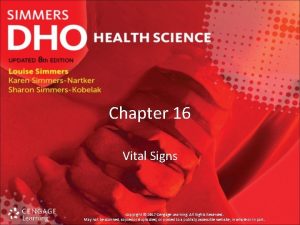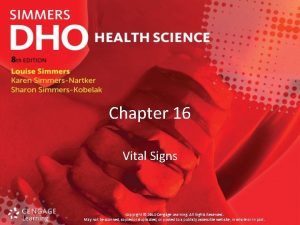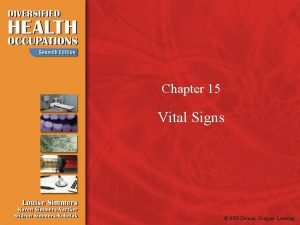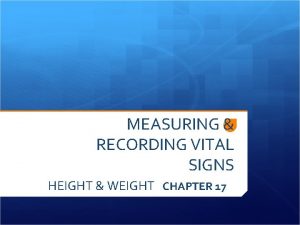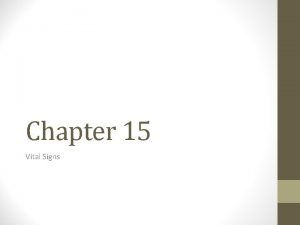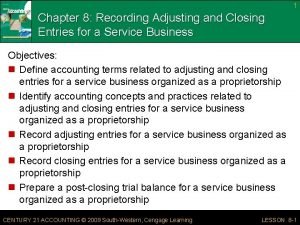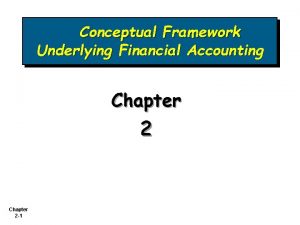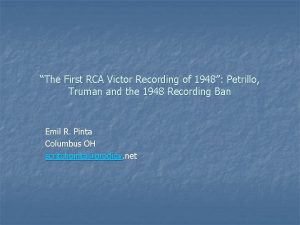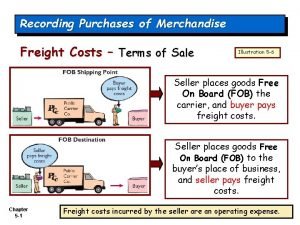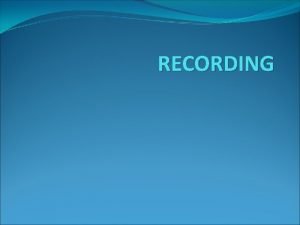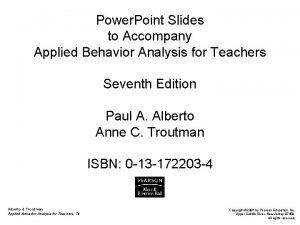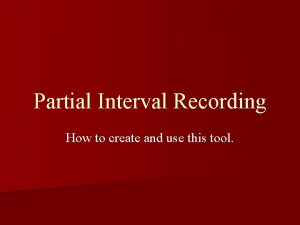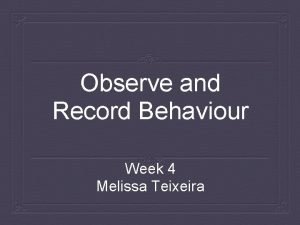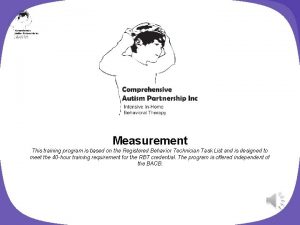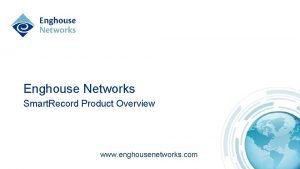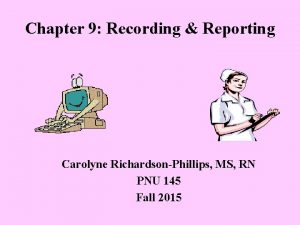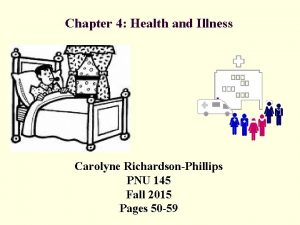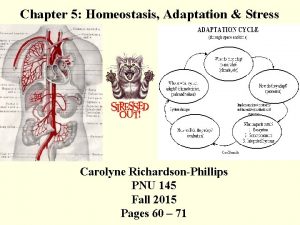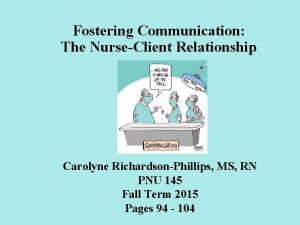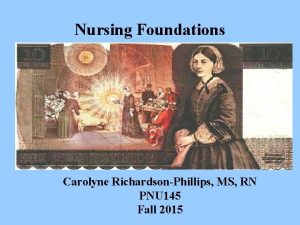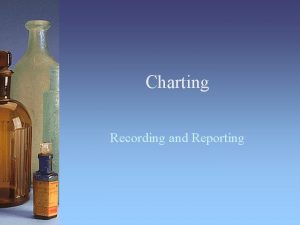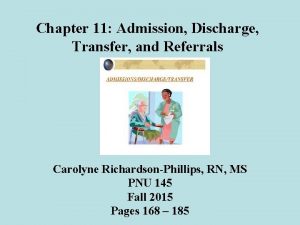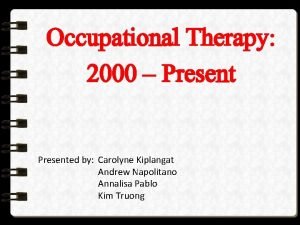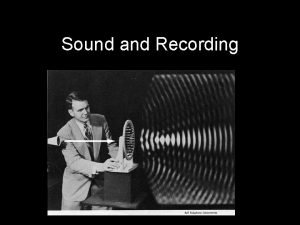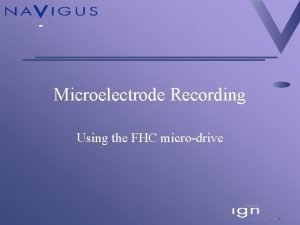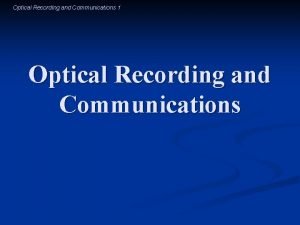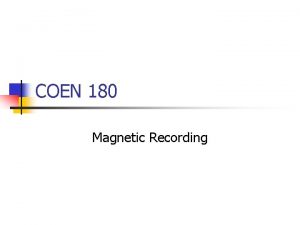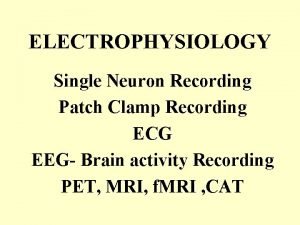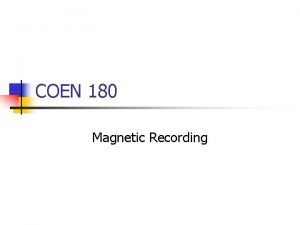Chapter 9 Recording Reporting Carolyne RichardsonPhillips MS RN


























- Slides: 26

Chapter 9: Recording & Reporting Carolyne Richardson-Phillips, MS, RN PNU 145 Fall 2015

Learning Outcomes: By the end of this session, the PN student will be able to: 1. Describe the components of a medical record 2. List the uses of a medical record 3. List & explain the common agency chart forms 4. Explain & differentiate between the 2 types of client records-sourceoriented & problem-oriented 5. List and define the six methods of charting 6. Explain Health Insurance Portability and Accountability Act (HIPAA) & how it protects health care information 7. List four aspects of documentation required in the medical records of all clients cared for in acute settings 8. Discuss why it is important to use approved abbreviations when charting 9. Explain how to convert traditional time & military time 10. List at least 10 guidelines that apply to charting 11. Discuss the written forms used to communicate information re: a patient 12. Discuss ways that health professionals exchange client information other than the medical record. 13. Discuss Nursing Process when entries are written in a patient’s record 14. Discuss the Do’s & Don’ts of written/typed documentation

Medical Records/Health Records/Client Records • Written/typed collections: information about a client’s health problems, care provided by health practitioners and client’s progress • ALL personnel involved contribute to medical record by: charting, recording, documenting • Medicare-Medicaid clients-Physicians need to computerize information by 2015 for payment • Forms –either in a chart or on computer- Face sheet, Advance directive, H&P, MD orders, progress notes, admission data, care plan, graphic sheet, nurses notes & assessments, Medication sheets, x-ray & lab reports, teaching notes, discharge plan

Uses of Medical Records • • Permanent account Sharing information Quality Assurance Accreditation Reimbursement Education Research Legal evidence

Client Access to Records • 1996 Health Insurance Portability & Accounting ACT (HIPPA) • Have right to see their medical record and billing records • Request changes to anything they feel is inaccurate • Be informed about who has seen their medical records • Nurses need to review & follow each facilities’ policy on client’s access to records

Two Types of Client Records • Source-Orientated Records • Traditional record (organized according to the source of documented information) • Each person/department makes notations in separate section (s) using narrative charting • Disadvantage: fragmented documentation • Problem-Orientated Records • Data arranged according to client’s health problems • Arranged information of importance: goal directed care, promote recording pertinent information & to facilitate communication with health professionals • Four components: data base, problem list, plan of care, & progress notes

Methods of Charting • Narrative charting: used in source-oriented records • Written information-chronologic order • No established format • Content resembles a log or journal • Time consuming • Entries may omit important information or may include information not needed • SOAP charting: Used in problem-oriented record • S = Subjective data -what client says; nurse quotes client’s words • O = Objective data- information that is measured/observed by use of the senses (ex. =vital signs, lab & x-ray results) • A = Assessment- analysis interpretation/conclusions drawn from subjective/objective information --- problem list created • P = Plan- plan of care

Method of Charting • Focus charting: Modified form of SOAP charting • Uses the word focus instead of problem • Intended to make the client and client concerns & strengths the focus of care • Progress notes organized into DAR • (D) data-assessment phase of nursing process • consists of observations –objective & subjective- EX: data from flow sheets (vital signs, pupil reaction) • (A) Action- reflects planning & implementation • (R) response - reflects evaluation • DAR reflects phases of nursing process

Method of Charting • SOAP: • S = Subjective data -what client says; nurse quotes client’s words • O = Objective data- information that is measured/observed by use of the senses (ex. =vital signs, lab & x-ray results) • A = Assessment- analysis interpretation/conclusions drawn from subjective/objective information --- problem list created • P = Plan- plan of care • SOAPIE or SOAPIER: Some agencies have added to SOAP notes • I = Intervention-specific interventions that have actually been performed by caregiver • E= Evaluation- includes client responses to nursing interventions & medical treatments • R = Revision- reflects care plan modifications to plan of care

Method of Charting • Focus Charting: Modified form of SOAP charting • Uses the word focus instead of problem • Intended to make the client and client concerns & strengths the focus of care • Progress notes organized into DAR • (D) data-assessment phase of nursing process • consists of observations –objective & subjective- EX: data from flow sheets (vital signs, pupil reaction) • (A) Action- reflects planning & implementation • (R) response - reflects evaluation • PIE charting: nursing care is documented using PIE; P = problems; I = interventions; E = evaluation • Nurses document assessments on a separate form –give client’s problems a corresponding number • Use these numbers in progress notes when referring to interventions & client responses

Method of Charting • Charting by Exception: Documentation -in which only abnormal assessment findings or care that is different – deviates from the standard are recorded • Quick access to abnormal findings • Does not describe normal & routine information • Computerized Documentation: documenting information electronically • Information quickly accessible – labs, x-ray reports, medications, procedure instructions, admission & discharge information, VS etc. • Advantages: information legible, records date & time of documentation, fewer omissions, saves time-eliminates charting, information easy to retrieve, abbreviations & terms consistent • In Long-term care setting –information put into Nursing Minimum Data Set –(MDS) source of patient care and electronically sent for payment •

Protecting Health Information-Privacy Standards • All health care agencies-required to protect health information • HIPAA legislation protects rights of U. S. citizens to retain health insurance • Requires Health Care Agencies to Protect the privacy of health records & security of that data whether written, spoken or electronic • Agencies-must submit a written notice to clients, obtain specific authorization to release information to family, friends, attorneys, research etc. • Client given a written notice-identifying uses & disclosures of their health information • Obtain client’s signature indicating knowledge if disclosure of information and right to learn who has seen the record • Limits casual access to identity of client and health information • Minimum disclosure: only disclose what is needed-not entire record • Beneficial disclosures: times when agencies can release information without the client’s approval

HIPAA Legislation Affecting the Workplace • • • Names -on chart must not be visible Clipboards must not have visible names/information Computer screens -away from public view Conversations about clients must be in a private area Fax machines, file cabinets etc. away from public view A cover sheet & statement indicating FAXed data must accompany electronically transmitted information • Light boxes for x-rays must be in private areas • Documentation must be kept of people who have access to charts • Whiteboards -free of client names-use initials only

Data Security • Computerized data • Assigned an access number and password for computer and or plastic key card for door access • If put in password etc. wrong 3 times-block out of computer • Automatic save or go back to menu • Minimize screen for privacy if needed • Do not leave computer with screen visible • Locking out client information-except to specific people • Blocking certain information- that personnel from other departments can retrieve • Storing time/location/access of person looking at client information • Encrypting information transmitted via internet

Documenting Information • Each agency-own documentation policies, type of information recorded, the people responsible for charting, and frequency for making entries • JCAHO-requires that medical records must identify steps of nursing process (assessment, diagnosis, planning, implementation, evaluation) • Abbreviations– Only use Standard abbreviations, terminology, symbols approved by agency-otherwise remove or write out word

Indicating Time • Document the date and time of each recording • Some agencies use traditional time (time based on two 12 -hour revolutions on a clock) • Identified with an hour and minute followed by AM or PM • Some agencies use military time (time based on a 24 hour clock) • Uses a different four digit number for each hour and minute of the day • Military time avoids confusion because no number is ever duplicated and AM, PM not used.

Other Forms of Written Communication • Nursing Care Plan – Required by JCAHO • List of Client’s problems, goals, nursing interventions, evaluations • Promotes-prevention, reduction or resolution of problems • Legal document-permanent record-each entry is signed • Nursing Kardex - Quick reference- Current information about client and care • Information changes frequently • Not a permanent record • Checklists-Form of documentation-initials or a check mark used when care is similar each day • Flow Sheets -recording for frequently repeated assessment data • Graphic record (vital signs) & Fluid Balance Sheet (I & O) • Other Sheets: • Medication Administration Record • Skin & Safety/Fall Assessments • Admissions, Transfer, Referral, Discharge • Other facility and or state and federal required documentation

Interpersonal Communication • Change of shift report -review client information to on-coming shift nurse • Client care assignments -made out beginning of shift • Team conferences- used to exchange information-includes personnel caring for client • Client rounds – visit with client one-on-one or a group • Telephone – communicate information-when not able come together • Repeat what was told to you back before documenting- to ensure correct information given & received

Receiving & Documenting Telephone Orders • Write down the time, date and order given on the physician’s order sheet • Read order back to physician to ensure it is accurately recorded • Record the physician’s name on the physician’s order sheet, state “telephone order” • Sign your name by the entry with your title • Always follow the agency’s policies • Some agencies have abbreviation of TORB (telephone order read back)

Nursing Process & Documentation • Nurses use or refer to Nursing Process as a guide to documentation, page 129 &130 • Assessment: observing client for signs & symptoms that may indicate actual or potential problems • Planning: developing a plan of care-directed at preventing, minimizing or resolving identified client problems or issues • Implementation: Performing the plan of care developed • Evaluation: determining if plan of care is working to minimize, prevent or resolve identified problems

Do’s for Documentation • All entries must be legible & easy to read • Permanent- written in dark ink • Correct spelling • Your Signature with title • Proper sequence • Appropriateness-Completeness • Accuracy • If using paper material • Mistake: Follow agency’s policy as to whether to write mistaken entry above or beside mistake or use the word error and then either put your initials or name • Draw a line through mistake rather than scribble through or obscure the words • DO NOT erase, blot out or use correction fluid • This is a legal document and the entry must remain visible

Do’s of Nursing Documentation • Use dark ink (BLACK pen) • Make sure you have correct chart/computer site before you begin writing/typing • Write/type legibly & spell words correctly • Chart completely, concisely and accurately • Remember to chart the time you gave a medication, administration route, and client’s response (s) • If using a computer –nurse’s pass word is put in- then you scan the client’s name tag/band before giving medication-as recorded on computer-you scan the medication bar code to justify the correct medication ordered and that it is on the medication sheet • Once given hit save on the computer and it shows up on the screen –the time medication given & nurse’s initials


Do’s of Nursing Documentation • Documentation should reflect nursing process & your professional capabilities • Record each phone call to a MD, including the exact time, message, and response • Chart as soon as possible after giving care • Log off computer when done or when leaving computer screen • Chart a client’s change in condition and follow-up actions that were taken • Chart all teaching • Chart a client’s refusal for treatment/medications etc. & reason why • Document why a medication was not given • If you have left something out, Write “late entry” or “addendum” with the time and chart if using paper chart • If using computer-some will allow you to go back and edit but will show up with that date • Include the following information when documenting a procedure: What procedure was performed; When it was performed; How well the client tolerated it; Any problems with the procedure

The No-No’s of Documentation • Don’t chart a symptom “c/o pain” without also charting what you did about it • Don’t change a client’s record…criminal offense • Don’t use shorthand or abbreviations that are not accepted • Don’t write vague descriptions (appears or seems) • Don’t chart your opinions • Don’t use negative language to describe your client • Don’t chart ahead of time • Never use ditto marks • Don’t record staffing problems or record staff conflicts • No white out or an eraser if using paper • No empty lines or spaces • No writing in margins • Don’t mention an incident report in the chart-document only the facts of the incident/accident • Don’t name a second client in chart • Do not chart for someone else

References • ATI Nursing Education (2013). Fundamentals of Nursing (8 th Ed) • Timby, B. K. (2013) (10 th ed. ). Fundamental Nursing Skills and Concepts. Philadelphia: PA. Lippincott Williams & Wilkins • Images-retrieved from web site on June 13, 2015 form www. http//: googleimages. com
 Role of nurse in maintaining records and reports
Role of nurse in maintaining records and reports Chapter 15:1 measuring and recording vital signs
Chapter 15:1 measuring and recording vital signs Chapter 16:7 reading a mercury sphygmomanometer
Chapter 16:7 reading a mercury sphygmomanometer Chapter 16:7 measuring and recording blood pressure
Chapter 16:7 measuring and recording blood pressure Chapter 15:2 measuring and recording temperature
Chapter 15:2 measuring and recording temperature Recording process accounting
Recording process accounting Chapter 21:1 measuring/recording height and weight
Chapter 21:1 measuring/recording height and weight Chapter 2 the recording process
Chapter 2 the recording process Where is apical pulse taken
Where is apical pulse taken 8-1 and 8-2 on your own accounting answers
8-1 and 8-2 on your own accounting answers Second level of conceptual framework
Second level of conceptual framework Segment and interim reporting chapter 8
Segment and interim reporting chapter 8 Chapter 2 conceptual framework for financial reporting
Chapter 2 conceptual framework for financial reporting Chapter 2 conceptual framework for financial reporting
Chapter 2 conceptual framework for financial reporting Recording vital signs
Recording vital signs Vertical jaw relations
Vertical jaw relations 1948 recording ban
1948 recording ban Recording purchases of merchandise
Recording purchases of merchandise Importance of recording in social case work process
Importance of recording in social case work process Event recording data sheet
Event recording data sheet Partial-interval recording
Partial-interval recording Event recording data sheet
Event recording data sheet Implement permanent product recording procedures
Implement permanent product recording procedures Recording in accounting process
Recording in accounting process Recording assistant hikvision
Recording assistant hikvision Autonomous recording units
Autonomous recording units Enghouse call recording
Enghouse call recording


